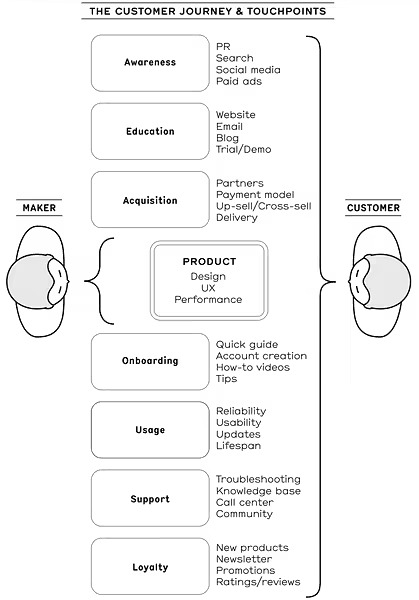When developing a new product you probably shouldn’t only focus on the product’s core offering, its functions, how it looks, does it work as users need it to, etc. Yes, this is really important, but it’s usually insufficient for most products. You also need to pay attention to the customer journey starting from their buying decision process, and experience while owning and maintaining the product, to the next product when its useful lifetime is over for them. According to famous tech manager Tony Fadell’s book, Build:
Makers often focus on the shiny object—the product they’re building—and forget about the rest of the journey until they’re almost ready to deliver it to the customer. But customers see it all, experience it all. They’re the ones taking the journey, step- by-step. And they can easily stumble and fall when a step is missing or misaligned.
But the customer journey can be split into eight steps which we’ll be going through here.

Prefer listening to reading?
1. Awareness.
Potential customers need to know that your product is out there as an option for them to consider. Being shown relatively high in Google searches or displayed by Amazon is a good start for many products. Advertising and other marketing work like promotional social media posts and videos might also be necessary to help start building awareness of products that are new to the market. Andrew formerly worked for GoPro and they built awareness simply by sharing awesome footage of exciting sports and activities taken using the product! Potential customers saw it and also wanted to be able to record and share their athletic feats and experiences.
Awareness is arguably one of, if not the most important part of the customer journey because if customers are not aware of the product you are in for a rough ride and it is the largest killer of startups. (04:49)
2. Education
Now that they have found the product, customers will usually have a lot of questions and so there needs to be a source of information to answer them. This may take the form of a website, FAQs pages, online manuals, social media posts, and even demos in shopping malls. Showing your product’s key specifications and USPs is particularly important. Early innovators and brand devotees may not require this information as much, but as soon as you start selling to the mainstream market education becomes very important. (13:06)
3. Acquisition.
How will the customer buy the product and how will it be delivered? You need to consider how distribution costs will affect you. For instance, if you sell via Amazon and your product is slightly too large to fit into the standard package, you will be charged a lot more for distribution in the larger size package. That could really hit your profit margin hard and could even kill it. Therefore, you should plan ahead and be aware of how product dimensions and weight could affect distribution.
E-commerce may not even be the best fit for, say, outdoor products. Maybe camping stores are the ideal location for customers to acquire the product, for example. You’ll need to research this in advance to see where your market tends to buy.
Amazon is an obvious sales platform, but it can be risky for selling new products because even small reliability issues that occur in new products that you can iron out relatively easily can affect your feedback rating and see the product kicked from the platform. Perhaps it’s better to start selling on your own e-commerce website to start with, and then when you know the product has no kinks left to iron out and most customers seem to be satisfied with its quality and reliability, you start selling on Amazon and harness its wide reach without the risk of being kicked off. You also need to be very careful to comply with Amazon’s certification requirements and provide all of the relevant testing certifications for your type of product, however, this can be missed by some manufacturers who are new to selling there.
You should also consider how the payment options you provide can affect sales. For instance, some customers may not be satisfied with only an option to pay via PayPal, demanding a credit card option, too.
Regarding IP protection and avoiding being copied quickly in China: Do NOT do Kickstarter or Indiegogo or get reviews by prominent tech bloggers and influencers. These may help the acquisition of course, but the negative side is that it puts out more than enough of your product information for it to be copied and signals to the copycats in Shenzhen that this is a ‘hot product’ worth paying attention to. Better to build momentum organically in your local market and then, once you have built a reputation and customer base, go big online and spread the word. By then it’s hopefully too late for the copycats to catch and overtake you. (17:51)
4. Product.
This is the main focus of most companies. The product needs to look good, work well, have USPs, etc. Yes, you do need to nail the product design and development process and bring a good product to market that fulfills customers’ needs (and there is LOT that goes into this that we have spoken and written about before, see the show notes), but the point still stands that if potential customers don’t know about it or what it does, all of this is for nothing. So block 4 is important, but the others absolutely must not be overlooked. (24:31)
5. Onboarding.
Once the customer has purchased the product, what should they do? If you have a really good product, but you do not provide easy-to-access or use onboarding information, such as a good manual, user videos, application, and easy-to-open packaging, you’re letting it down and it may cause customer frustration. On the other hand, customers who can easily start using the product will tend to share how happy they are with the onboarding process which gives awareness to even more customers that you have a good product. Unboxing videos by influencers are also a really great way for manufacturers to show how easy it is to get the new product set up and ready to use quickly, as well as how to use its functions, so it may be that 3rd party content like this does a really effective job when utilized carefully. (27:39)
6. Usage.
Once the product is in use the manufacturer’s job is not done yet. There will be software updates to roll out for many electronics, for example. Also, this is where product reliability and durability really come into focus. Customer expectations need to be considered when building the product and testing for reliability. If it’s a high-value product that is meant to be durable, this will be a key concern during product design and reliability testing will probably be quite comprehensive, whereas for lower-value products that aren’t meant to have a long lifespan, these factors become less important. Sometimes you can gain some insight into what customer usage expectations are by checking the warranty documentation of competing products, for example, as this will show what is and isn’t covered and for how long. (32:15)
7. Support.
Where can customers go if they have questions or issues? The manufacturer needs to offer support and the most common are troubleshooting guides. They may also provide a customer support them to answer questions, or at least a forum where customers can answer each other in a form of community. If a customer damages a high-value product and the process to get it repaired is really expensive and/or inconvenient, this is likely to drive them away to other brands. A good example of customer service gone wrong is the case of ‘Dell Hell‘ where computer firm Dell’s customer phone support put customers into an almost inescapable labyrinth of phone menus where automated ‘assistants’ never offered them what they needed. Good customer service also builds loyalty, so the two are connected. (38:08)
8. Loyalty.
How do you keep your customers engaged with your brand after they’ve purchased products and have been using them? Gathering their email address at the point of sale helps you build a mailing list that you can reach out to via newsletter to share new products, promotions, etc. That’s easier if it’s through your own website. A way to gather reviews is also helpful, especially if you control it such as a Google business page, as reviews are helpful for driving awareness in new customers. (41:51)
In conclusion.
If you’re manufacturing a new product, focusing on its functions, looks, and how it meets customers’ needs is important, but there is a lot more we’ve gone through in the customer journey that you need to think about in order to have a successful product launch and have satisfied customers coming back for more. (48:22)

